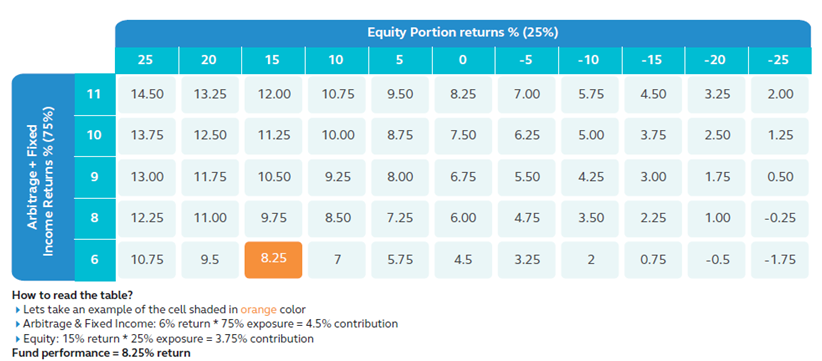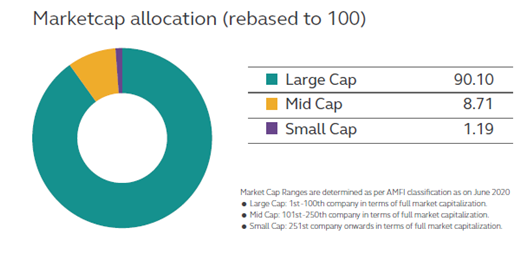Equity Savings Fund invests in equity, arbitrage opportunities and debt & money market instruments. In the current scenario, how does that place the fund in terms of risk-reward proposition?
The Equity Savings Fund is a hybrid fund investing in debt and equity instruments. A part of the equity allocation is invested in arbitrage positions. The fund allocation is designed to help reduce potential volatility and downside risk in the portfolio. This strategy may lower the risk of the fund vis-à-vis equity funds. Consequently, the potential upside from equity returns is also limited by the lower equity allocation.
A pictorial representation is given below to illustrate the various components of returns that may be generated in the equity savings category.

The equity and debt + arbitrage exposure given above is only to illustrate the effect of returns on the portfolio based on the exposure. The actual exposure of the fund may be different. The figures in the above table are based on the assumptions on the asset allocation and returns. It is provided for illustration purposes only and should not be construed as indicative yield or return. The above numbers are gross and will reduce based on expenses that shall be charged to the fund. The actual numbers may be more or less depending on the securities market movement. There may arise a situation where good arbitrage opportunities are not available and hence the allocation of the fund may be different as stated in the SID.
In the last one year, while most equity funds have given negative returns, Principal Equity Savings Fund has delivered positive returns. In fact, it has outperformed most of the funds in this category. What are the three things that have contributed to this performance?
The performance of Principal Equity Savings fund in last 1 year can be primarily attributed to wider range of net equities allocation. The portfolio can invest in net long equities ranging from 15% to 50% of the fund’s asset. As on 31st July 2020, the fund exposure to net equities was about 47%. Additionally, the allocation to equities is  predominantly tilted towards large cap companies. Bottom up stock selection based on our 6 pillars investment process has been the key in identifying right companies for investments.
predominantly tilted towards large cap companies. Bottom up stock selection based on our 6 pillars investment process has been the key in identifying right companies for investments.
Many distributors recommend equity savings schemes to protect the downside risk. What is your strategy to minimize the downside risk in Principal Equity Savings Fund?
The asset allocation of the Equity Savings Fund provides for net (unhedged) equity exposure in the range of 15% to 50%. The balance is invested in arbitrage positions and debt instruments. The hedged equity and debt allocation is invested with a view to help generate income and try to reduce volatility at the overall portfolio level. Even within the unhedged equity portion, we aim to maintain a well-diversified portfolio to reduce risk. Further, given the conservative nature of the investors in the fund, the equity allocation is primarily invested in large cap companies.
What are the key challenges in managing equity savings fund?
The challenges in managing the equity savings fund is similar to other mutual fund schemes. The fund is managed within the asset allocation and investment strategy outlined in the Scheme Information Document. We have dedicated fund managers to manage the equity and debt allocations of the portfolio.
Financial planners argue that investors should not view Equity Savings Fund in the same light as equity funds for long-term portfolios. What equity savings funds offer is better tax efficiency as against debt funds and regular income. What is your view on this?
Equity Savings Funds are funds with lesser volatility and risk when to compared to pure equity funds. The asset allocation makes this funds tax efficient vis-à-vis debt funds. These funds are suitable for investors who seek equity investments while at the same time are wary of the risk and volatility associated with investments in equity markets and therefore are seeking solutions that would reduce such risks and volatility. We believe equity savings funds are suitable medium to long term investment solutions for investors seeking income generation and capital appreciation over a period of time.
How should distributors position this fund among their clients? And which type of investors should invest in Principal Equity Savings Fund?
The Equity Savings Fund is suitable for investors with a moderate to high risk appetite seeking to generate income and capital appreciation from their portfolios over a period of time. As mentioned earlier, such products are suitable for investors seeking to participate in the equity markets but are wary of the volatility in equity markets. The portfolio is designed to provide participation in equity markets, comparatively lower volatility and also generate income from the debt allocation. The returns also get accordingly capped since only upto 50% of the portfolio is invested in unhedged equity.
How Principal Equity Savings Fund is different from other such funds in the market. Why do you think distributors should recommend this scheme to their clients?
*The Principal Equity Savings Fund has 3 components – equity, debt and arbitrage. Unhedged equity can be upto 50% of the portfolio and provides the potential capital appreciation in the portfolio; the arbitrage and debt allocation provides potential income generation and also potentially reduces volatility in the portfolio.
How is the debt portfolio of the fund positioned? What is YTM and Duration of the Fund
The debt portion of the fund comprises of high-quality fixed income instruments and the duration is actively managed. As on 31st Jul 2020, the Fund’s Gross YTM and Modified Duration was 4.55% and 330 Days respectively.





